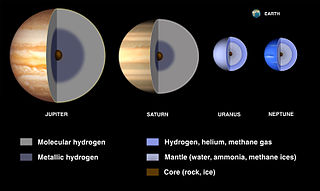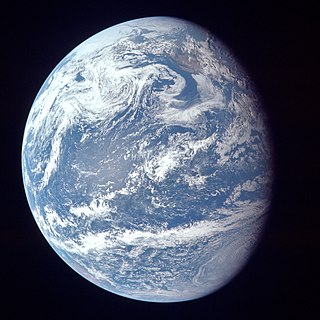
A terrestrial planet, telluric planet, or rocky planet, is a planet that is composed primarily of silicate rocks or metals. Within the Solar System, the terrestrial planets accepted by the IAU are the inner planets closest to the Sun: Mercury, Venus, Earth and Mars. Among astronomers who use the geophysical definition of a planet, two or three planetary-mass satellites – Earth's Moon, Io, and sometimes Europa – may also be considered terrestrial planets. The large rocky asteroids Pallas and Vesta are sometimes included as well, albeit rarely. The terms "terrestrial planet" and "telluric planet" are derived from Latin words for Earth, as these planets are, in terms of structure, Earth-like. Terrestrial planets are generally studied by geologists, astronomers, and geophysicists.

In planetary science, planetary differentiation is the process by which the chemical elements of a planetary body accumulate in different areas of that body, due to their physical or chemical behavior. The process of planetary differentiation is mediated by partial melting with heat from radioactive isotope decay and planetary accretion. Planetary differentiation has occurred on planets, dwarf planets, the asteroid 4 Vesta, and natural satellites.

A planetary core consists of the innermost layers of a planet. Cores may be entirely solid or entirely liquid, or a mixture of solid and liquid layers as is the case in the Earth. In the Solar System, core sizes range from about 20% to 85% of a planet's radius (Mercury).

Gliese 876 d is an exoplanet 15.2 light-years away in the constellation of Aquarius. The planet was the third planet discovered orbiting the red dwarf Gliese 876, and is the innermost planet in the system. It was the lowest-mass known exoplanet apart from the pulsar planets orbiting PSR B1257+12 at the time of its discovery. Due to its low mass, it can be categorized as a super-Earth.

An ocean world, ocean planet, panthalassic planet, maritime world, water world or aquaplanet, is a type of planet that contains a substantial amount of water in the form of oceans, as part of its hydrosphere, either beneath the surface, as subsurface oceans, or on the surface, potentially submerging all dry land. The term ocean world is also used sometimes for astronomical bodies with an ocean composed of a different fluid or thalassogen, such as lava, ammonia or hydrocarbons. The study of extraterrestrial oceans is referred to as planetary oceanography.

A Super-Earth is a type of exoplanet with a mass higher than Earth's, but substantially below those of the Solar System's ice giants, Uranus and Neptune, which are 14.5 and 17 times Earth's, respectively. The term "super-Earth" refers only to the mass of the planet, and so does not imply anything about the surface conditions or habitability. The alternative term "gas dwarfs" may be more accurate for those at the higher end of the mass scale, although "mini-Neptunes" is a more common term.
This page describes exoplanet orbital and physical parameters.

A hot Neptune or Hoptune is a type of giant planet with a mass similar to that of Uranus or Neptune orbiting close to its star, normally within less than 1 AU. The first hot Neptune to be discovered with certainty was Gliese 436 b in 2007, an exoplanet about 33 light years away. Recent observations have revealed a larger potential population of hot Neptunes in the Milky Way than was previously thought. Hot Neptunes may have formed either in situ or ex situ.

CoRoT-7b is an exoplanet orbiting the star CoRoT-7 in the constellation of Monoceros, 489 light-years from Earth. It was first detected photometrically by the French-led CoRoT mission and reported in February 2009. Until the announcement of Kepler-10b in January 2011, it was the smallest exoplanet to have its diameter measured, at 1.58 times that of the Earth and the first potential extrasolar terrestrial planet to be found. The exoplanet has a very short orbital period, revolving around its host star in about 20 hours.
A coreless planet is a theoretical type of terrestrial planet that has no metallic core and is thus effectively a giant rocky mantle. It can be formed in cooler regions and far from the star.

An exoplanet is a planet located outside the Solar System. The first evidence of an exoplanet was noted as early as 1917, but was not recognized as such until 2016; no planet discovery has yet come from that evidence. What turned out to be the first detection of an exoplanet was published among a list of possible candidates in 1988, though not confirmed until 2003. The first confirmed detection came in 1992, with the discovery of terrestrial-mass planets orbiting the pulsar PSR B1257+12. The first confirmation of an exoplanet orbiting a main-sequence star was made in 1995, when a giant planet was found in a four-day orbit around the nearby star 51 Pegasi. Some exoplanets have been imaged directly by telescopes, but the vast majority have been detected through indirect methods, such as the transit method and the radial-velocity method. As of 1 March 2024, there are 5,640 confirmed exoplanets in 4,155 planetary systems, with 895 systems having more than one planet. This is a list of the most notable discoveries.

A mega-Earth is a proposed neologism for a massive terrestrial exoplanet that is at least ten times the mass of Earth. Mega-Earths would be substantially more massive than super-Earths. The term "mega-Earth" was coined in 2014, when Kepler-10c was revealed to be a Neptune-mass planet with a density considerably greater than that of Earth, though it has since been determined to be a typical volatile-rich planet weighing just under half that mass.
HD 219134 c, also known as HR 8832 c, is a hot, dense, rocky exoplanet orbiting around the K-type star HD 219134 in the constellation of Cassiopeia. Originally thought to be a little less than three times the mass of Earth, it is now known to be over 4 times the mass and 51% larger in radius, suggesting a rocky composition with a higher quantity of iron than Earth. The exoplanet was initially detected by the instrument HARPS-N of the Italian Telescopio Nazionale Galileo via the radial velocity method. Transits of the planet were observed by the Spitzer Space Telescope in 2017. Later that year, it was predicted that HD 219134 c has an atmosphere.
K2-229b is an extremely hot, solid, iron-rich exoplanet in a close orbit around the active K-dwarf K2-229 in the constellation Virgo, 335 light years away from Earth.

LHS 3844 b, formally named Kua'kua, is an exoplanet orbiting the red dwarf LHS 3844, about 48.5 light-years away in the constellation Indus, discovered using the Transiting Exoplanet Survey Satellite. It orbits its parent star once every 11 hours, and its radius is 1.32 times that of Earth. It has a low albedo, indicating that its surface may resemble that of the Moon or Mercury. LHS 3844 b probably does not have an atmosphere as almost no heat goes to its night side, and it has a dayside temperature of 1,040 K. The presence of cloudy atmosphere with cloud tops above pressure level of 0.1 bar cannot be excluded though.
Gliese 367 b, formally named Tahay, is a sub-Earth exoplanet orbiting the red dwarf star Gliese 367, 30.7 light-years from Earth in the constellation of Vela. The exoplanet takes just 7.7 hours to orbit its star, one of the shortest orbits of any planet.

Over the years, our ability to detect, confirm, and characterize exoplanets and their atmospheres has improved, allowing researchers to begin constraining exoplanet interior composition and structure. While most exoplanet science is focused on exoplanetary atmospheric environments, the mass and radius of a planet can tell us about a planet's density, and hence, its internal processes. The internal processes of a planet are partly responsible for its atmosphere, and so they are also a determining factor in a planet's capacity to support life.
HD 260655 is a relatively bright and cool M0 V red dwarf star located 33 light-years away from the Solar System in the constellation of Gemini. HD 260655 has two confirmed rocky planets, named HD 260655 b and HD 260655 c, that were discovered in 2022. Both planets were detected by the TESS mission and confirmed independently with archival and new precise radial velocity data obtained with the HIRES observatory since 1998, and the CARMENES survey instruments since 2016.














